
General Larry D. Welch is a retired United States Air Force four-star general who served as the 12th Chief of Staff of the United States Air Force. As Chief of Staff, he served as the senior uniformed Air Force officer responsible for the organization, training and equipping of a combined active duty, Guard, Reserve and civilian force serving at locations in the United States and overseas. As a member of the Joint Chiefs of Staff, he and the other service chiefs functioned as the principal military advisers to the Secretary of Defense, National Security Council and the President. He currently serves as the Chairman of the Nuclear Weapon Surety Task Force for the Defense Science Board.

Lieutenant General Tome H. Walters Jr. was Director, Defense Security Cooperation Agency, Office of the Secretary of Defense, Arlington, Virginia. The agency directs and oversees U.S. foreign military sales, foreign military financing programs, international military education and training programs, and humanitarian assistance and demining programs.

General William Sebastian Stone was an American United States Air Force Major General and the third Superintendent of the United States Air Force Academy. His final assignment was as the air deputy to the Supreme Allied Commander Europe.

Richard Hastings Ellis was a United States Air Force general who served as the commander in chief of the Strategic Air Command and director of the Joint Strategic Target Planning Staff with headquarters at Offutt Air Force Base, Nebraska. He was also director of the Joint Strategic Connectivity Staff.

George Lee Butler, sometimes known as Lee Butler, is an American retired military officer. He was commander in chief, United States Strategic Command, and the last commander of Strategic Air Command. Following his retirement from the military he became active in the nuclear disarmament movement, calling for the outright abolition of nuclear weapons.

General Lucius DuBignon Clay Jr. was a United States military leader who held the positions of commander-in-chief of the North American Air Defense Command, the Continental Air Defense Command, the United States element of NORAD, and was also a commander of the United States Air Force's Aerospace Defense Command. His father, Lucius D. Clay Sr. and his brother, Frank Butner Clay, were also both generals, and his grandfather was Senator Alexander Stephens Clay of Georgia.

General Robert James Dixon, USAF was a United States Air Force four-star general and Command Pilot who served as Commander, Tactical Air Command (COMTAC) from 1973 to 1978. He also served simultaneously as commander in chief of U.S. Air Forces for both the U.S. Atlantic Command and U.S. Readiness Command.
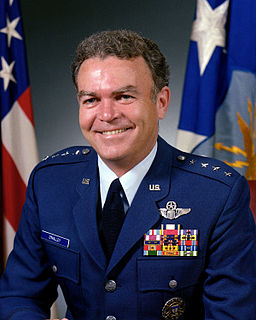
General Jerome Francis O'Malley was a United States Air Force four-star general who served as Vice Chief of Staff, U.S. Air Force (VCSAF) from 1982 to 1983; Commander in Chief, Pacific Air Forces (CINCPACAF) from 1983 to 1984; and Commander, Tactical Air Command (COMTAC) from 1984 to 1985. He died in an airplane crash while still in command of Tactical Air Command.
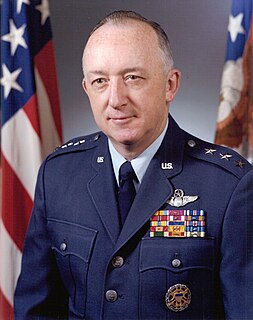
James Edward Dalton is a former general and former chief of staff of the Supreme Headquarters Allied Powers Europe.
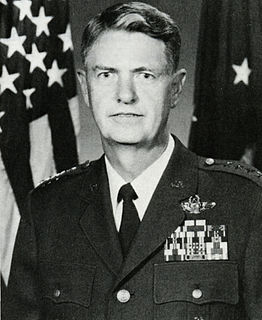
Monroe W. Hatch Jr. is a former general in the United States Air Force and the former Vice Chief of Staff of the United States Air Force.
C. Donald Alston is a retired major general in the United States Air Force.
Franklin J. Blaisdell is a retired major general in the United States Air Force.

Donald O'Neal Aldridge is a retired lieutenant general in the United States Air Force.

John A. Bradley was a lieutenant general in the United States Air Force who served as Commander of the United States Air Force Reserve Command, Headquarters U.S. Air Force, Washington D.C., and commander, Headquarters Air Force Reserve, a separate operating agency located at Robins Air Force Base, Georgia. As chief of Air Force Reserve, he served as the principal adviser on Reserve matters to the Air Force Chief of Staff. As commander of AFRES, he had full responsibility for the supervision of U.S. Air Force Reserve units around the world. He served in this position from November 1994 to June 1998.

Major General William K. James of United States Air Force, was director of the Defense Mapping Agency (DMA) between June 1990 and June 1993. Under his leadership Major General James redirected the DMA – a heritage organization of the National Geospatial-Intelligence Agency – from producing products to meet the requirements of the Cold War to a concept of a Global Geospatial Information System (GGIS) directly accessible to combat commanders of the Rapid Deployment Forces. The GGIS was a major paradigm shift in warfare with the delivery of geographic information to fast-moving military forces.

Major General Philip William Nuber of United States Air Force, was director of the Defense Mapping Agency from December 1994 to May 1996.

Major General Robert Alan "Rosie" Rosenberg of United States Air Force was Director of Defense Mapping Agency from July 1985 to September 1987. Throughout his 30-year career with the U.S. Air Force, he was instrumental to the U.S. satellite program. National Geospatial-Intelligence Agency inducted him into its Hall of Fame in 2005.
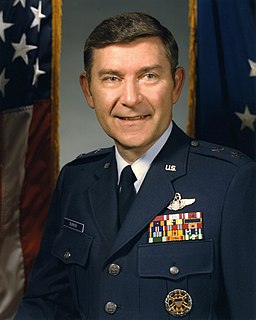
Major General Robert Francis Durkin of the United States Air Force was Director of Defense Mapping Agency from October 1987 to June 1990. As director, Durkin restructured the Defense Mapping Agency's international and domestic training in the production and exploitation of geospatial information.

Melbourne Kimsey is a retired brigadier general in the United States Air Force who served as director of the Cheyenne Mountain Complex from 1981 to 1983,
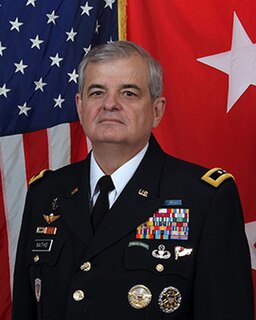
Jeff W. Mathis III was a career officer in the United States Army. A longtime member of the Army National Guard, Mathis attained the rank of major general before retiring in 2014. A veteran of overseas deployment to Africa during the Global War on Terrorism, he was most notable for high profile command assignments including Joint Task Force – Civil Support (2012-2014) and I Corps (2009-2010).


















